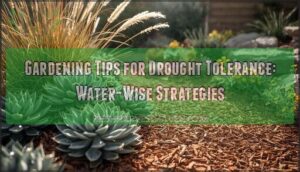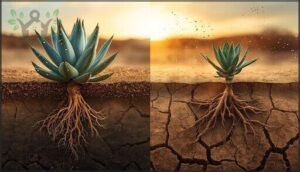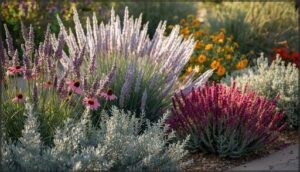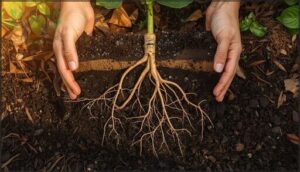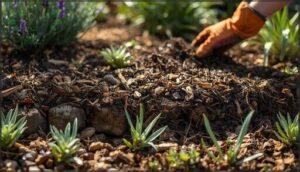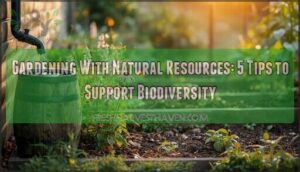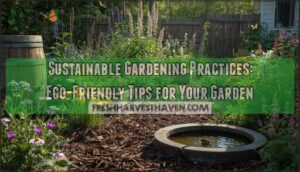This site is supported by our readers. We may earn a commission, at no cost to you, if you purchase through links.
Water scarcity isn’t just a future concern—it’s already reshaping how you need to approach your garden. Traditional lawns and water-hungry ornamentals can consume thousands of gallons each season, straining both municipal supplies and household budgets.
The good news is that drought-tolerant gardening doesn’t mean sacrificing beauty or productivity. By understanding how plants adapt to limited moisture and applying the right techniques, you can create a landscape that thrives even during extended dry spells.
Strategic plant selection, soil improvements, and efficient irrigation methods work together to reduce your water use while maintaining a vibrant outdoor space that benefits local ecosystems.
Table Of Contents
- Key Takeaways
- Choosing Drought-Tolerant Plants
- Improving Soil for Drought Resilience
- Smart Water Conservation Strategies
- Mulching and Groundcover for Moisture Retention
- Seasonal and Design Tips for Dry Gardens
- Frequently Asked Questions (FAQs)
- How can I Make my Garden more drought-resistant?
- What makes a plant drought tolerant?
- How do I design a drought tolerant landscape?
- How do I choose a drought tolerant plant for late summer?
- How do I make my lawn drought tolerant?
- How do I prepare my garden for a drought?
- How do I transition conventional gardens to drought-tolerant landscapes?
- What are common mistakes when establishing drought plants?
- How do I maintain color throughout seasons with drought plants?
- Can I grow drought-tolerant plants in containers successfully?
- Conclusion
Key Takeaways
- Strategic plant selection prioritizing native species with deep root systems, waxy leaf surfaces, and enhanced osmotic adjustment can reduce irrigation demands by 50-70% while maintaining garden productivity and supporting local pollinators.
- Improving soil organic matter from 1% to 4% more than doubles water-holding capacity, storing thousands of additional gallons per acre, while no-till practices combined with cover crops increase water storage by 27% and boost grain production by 30% during droughts.
- Drip irrigation and soaker hoses achieve over 90% water efficiency compared to 50-70% for sprinklers, and deep, infrequent watering builds root systems that penetrate 9-39% deeper while boosting overall water efficiency by 18.7%.
- Applying 3-4 inches of organic mulch on moist soil increases moisture retention by up to 80% compared to bare ground, while replacing traditional lawns with drought-resistant groundcovers can slash irrigation by 40-50 million gallons annually.
Choosing Drought-Tolerant Plants
The right plants make all the difference when you’re gardening in dry conditions. Instead of fighting against your climate, you can work with it by choosing species that thrive naturally with less water.
Let’s look at the specific traits and varieties that’ll work best for your garden.
Key Traits of Drought-Resistant Species
Understanding what makes plants drought-resistant helps you select species that’ll thrive with minimal water. Drought-tolerant plants have evolved specific survival mechanisms worth knowing. Root systems that grow deep and steep access water reserves shallow roots can’t reach. Leaf adaptations like waxy or silvery surfaces reduce water loss considerably. Plants also undergo osmotic adjustment, accumulating compounds that maintain cell function during dry spells. These traits combine to create plant resilience in water-limited conditions. Recent research highlights the benefits of steep, cheap, and deep root systems for drought tolerance.
Key characteristics to look for:
- Deep taproots accessing soil moisture at greater depths
- Thicker leaf cuticles with waxy coatings reducing transpiration
- Enhanced proline accumulation for osmotic balance
- Higher intrinsic water use efficiency during photosynthesis
- Established mycorrhizal associations improving soil water uptake
Native Vs. Non-Native Plant Selection
When selecting drought-tolerant plants, prioritize native species adapted to your local climate. Native plants generally develop deeper root systems and allocate more biomass to roots during dry periods, making them fundamentally more water-efficient than non-native alternatives.
While non-natives may recover quickly after rain, natives maintain better overall resilience and support local ecosystem services. Native water efficiency translates to lower irrigation demands, reduced maintenance, and stronger pollinator support in your garden’s microclimate. These plants also require less maintenance because they’re drought resistant.
Top Drought-Tolerant Flowers, Shrubs, and Edibles
Now that you’ve prioritized native species, you’re ready to stock your garden with specific plants that thrive on minimal water. Drought-tolerant flowers like lavender and purple coneflower deliver color through summer and fall. For structure, consider Russian sage or butterfly bush—xerophytic shrubs that anchor dry gardens beautifully.
Edible herbs such as rosemary and sage give you culinary rewards, while groundcovers like sedums replace thirsty lawns. These water conservation choices transform your landscape into a resilient, productive space.
Pollinator-Friendly and Edible Options
Beyond ornamental appeal, your drought-tolerant plants can feed you and support pollinators. Native edible species like rosemary and lavender thrive on 50–70% less water than conventional plants while producing nectar that attracts bees. Figs, olives, and pineapple guavas maintain fruit production with minimal supplemental irrigation in suitable climates.
Forest gardens layering fruit trees, shrubs, and herbs create natural moisture retention while boosting yields. This integrated approach combines water conservation with food production and pollinator support—making your garden both resilient and productive.
Improving Soil for Drought Resilience
Your soil is largely the foundation that determines how well your garden survives dry spells, so it’s worth getting it right. The good news is you don’t need to start from scratch—most soils can be greatly improved with some straightforward techniques.
Let’s walk through the practical steps you can take to build soil that holds water, bolsters plant roots, and keeps your garden thriving even when rain is scarce.
Adding Organic Matter and Compost
Your soil acts like a sponge—the better its structure, the more water it holds during dry spells. Adding compost transforms this capacity dramatically. When you increase organic matter from 1% to 4%, your soil’s water-holding ability more than doubles, storing thousands of additional gallons per acre.
Boosting soil organic matter from 1% to 4% more than doubles your garden’s water-holding capacity during droughts
Compost itself holds roughly 20 times its weight in water, functioning as a natural reservoir. Apply 3–5 tons annually for high-nitrogen compost, adjusting based on your soil type and climate needs for lasting drought resilience.
Aeration Techniques to Reduce Compaction
Compacted soil suffocates plant roots and blocks water infiltration, making aeration essential for drought resilience. Core aeration removes soil plugs 2–3 inches deep, reducing bulk density by 8–14% and dramatically improving water movement through the root zone.
For clay soils under foot traffic, aim for annual aeration; sandy soils need it every 2–5 years. Spring or early fall timing lets roots rapidly recolonize aeration channels during active growth periods, maximizing your soil’s water-holding capacity when plants need it most.
Adjusting Soil PH for Optimal Growth
Soil pH acts like a gatekeeper for nutrient availability—get it right, and your drought-tolerant plants thrive; get it wrong, and they starve despite adequate water. Most crops perform best when pH sits between 6.0 and 7.5, where nitrogen, phosphorus, and potassium become accessible to roots. Testing your soil reveals where you stand, then targeted amendments bring balance back.
- Lime application raises pH in acidic soils, enhancing phosphate availability
- Biochar, manure, and straw amendments increase pH by 12–15% respectively
- Favorable pH boosts microbial activity essential for nutrient cycling and drought resilience
- Neutral soils promote faster ammonium-to-nitrate conversion, improving plant nutrition
No-Till and Cover Cropping Practices
When you stop turning your soil, you’re basically letting it heal. No-till practices combined with cover crops increase soil water storage by up to 27%, boost infiltration by over 180%, and reduce erosion greatly. Your plants get deeper, more stable water access during dry periods.
Long-term field research shows no-till systems yield 30% higher grain production with 33% better water-use efficiency during droughts. You’re building carbon sequestration while improving soil health and moisture retention—a system that works with nature, not against it.
Smart Water Conservation Strategies
Watering efficiently is the backbone of any drought-resistant garden, but it’s not just about how much water you give your plants—it’s about getting that water to the roots where it matters most.
The right approach can cut your water use dramatically while actually making your plants healthier and more resilient.
Let’s look at the specific strategies that’ll help you water smart and watch your garden thrive.
Drip Irrigation and Soaker Hose Benefits
When water matters most, drip irrigation and soaker hoses deliver it right where your plants need it—directly at the roots. These efficient irrigation techniques achieve over 90% water efficiency compared to just 50-70% for sprinklers, cutting your water bills dramatically while boosting yields by 20-50%.
- Drip systems reduce evaporation losses and minimize runoff on slopes
- Soaker hoses require minimal maintenance with no emitters to clog
- Both methods cut pumping energy needs by half, lowering operational costs
Installing efficient irrigation transforms your garden’s resilience.
Deep and Infrequent Watering Methods
Rather than watering lightly and frequently, try deep, infrequent irrigation—it’s the secret to building stronger root systems. When you water deeply, roots penetrate 9-39% deeper into soil layers, accessing moisture reserves that sustain plants through dry spells.
This method boosts water efficiency by 18.7% while reducing evaporation losses. Clay soils especially benefit, retaining moisture 24-48 hours longer between waterings.
You’ll achieve plant resilience with less frequent intervention, transforming your garden’s drought tolerance fundamentally.
Grouping Plants by Water Needs (Hydrozoning)
Now that you’ve mastered deep watering, consider organizing your garden into hydrozones—distinct irrigation areas grouped by plant water needs. This zone establishment strategy prevents overwatering drought-tolerant species while ensuring thirsty plants get adequate moisture.
By matching irrigation hardware and schedules to each zone’s specific demands, you’ll cut outdoor water use by 15–30%. Assign plants to routine, reduced, limited, or no-irrigation categories based on their water requirements and microclimate exposure, then adjust accordingly.
Using Rainwater and Graywater Systems
After hydrozoning your beds, capture alternative water sources to further boost conservation. Rainwater harvesting systems can replace 40–50% of household demand—a typical residential roof yields around 48,000 liters annually.
Graywater safety guidelines permit subsurface irrigation for ornamentals when you use low-sodium detergents; this approach promotes sustainable gardening while avoiding mains water. System design choices reflect market growth toward smart, sensor-equipped tanks. Soil response data confirm that proper graywater use sustains plantings without elevated risk, delivering measurable water savings.
- Install storage tanks to collect roof runoff for dry-season irrigation.
- Route graywater from sinks and washing machines to mulch basins around ornamentals.
- Choose biodegradable, low-sodium products to protect soil chemistry over time.
- Automate with sensors that monitor tank levels and trigger drip lines.
- Rotate irrigation zones periodically to let soil microbiology rebalance naturally.
Monitoring Soil Moisture Efficiently
Once your alternative water sources are in place, sensor calibration ensures you don’t waste them. Data interpretation from capacitive probes can cut irrigation by 38% when paired with smart controllers. Manual methods—squeeze a handful from monitoring depth around 10 cm—give you a free reference point. Track trends weekly, adjust watering techniques as readings drop, and watch soil health improve while water retention climbs.
| Method | Accuracy | Best Use |
|---|---|---|
| Capacitive sensor | ±1.6–7.4% | Automated efficient irrigation |
| Tensiometer | ±10% (maintained) | Root-zone tracking |
| Feel test | ±10% | Low-cost verification |
Mulching and Groundcover for Moisture Retention
Mulching and groundcover work like a protective blanket over your soil, locking in moisture and keeping roots cool during dry spells. The right materials and techniques make a measurable difference in how long your soil stays hydrated between waterings.
Here’s how to use mulch and groundcover strategically to conserve water and reduce your garden’s thirst.
Types of Mulch for Water Conservation
You’ve got two main mulch families to choose from: organic mulch like bark, straw, and newspaper, which boost soil health while conserving water in gardens, and inorganic mulch such as gravel or rock fragments.
Organic options absorb moisture—hemp bedding holds 80% of added water—while using mulch and coir creates natural sponges.
Mulch thickness matters: 5 cm reduces evaporation to 40% of bare soil, optimizing mulch performance and absorption.
Applying Mulch for Maximum Benefit
To boost mulch’s water-saving power, spread a 3–4 inch layer on moist, weed-free soil—research shows that moderate mulch depth increases soil moisture by up to 80% compared to bare ground.
Keep mulch 4 inches from tree trunks to prevent bark decay while conserving water in the root zone.
Refresh your mulch layer each spring to maintain consistent evaporation control and soil moisture throughout the growing season.
Replacing Lawns With Drought-Resistant Groundcovers
Switching lawn areas to drought-tolerant groundcovers can slash irrigation by 40–50 million gallons annually, as demonstrated at Arizona golf courses. Successful groundcover establishment depends on three factors:
- Remove existing turf by smothering with cardboard, leaving it as organic matter
- Add 1–3 inches of compost to improve water retention
- Apply mulch during establishment until living cover forms
These lawn alternatives reduce mowing to once yearly while supporting pollinators and local wildlife.
Permeable Hardscaping to Reduce Runoff
Beyond plant and soil choices, permeable hardscaping elements like porous pavers or gravel pathways capture rainwater runoff and funnel it back into the ground. Permeable surfaces reduce stormwater runoff by 60–90%, compared to standard asphalt’s 32% reduction. Installation standards require a minimum 3-foot separation from groundwater and proper base layers, while maintenance involves quarterly sweeping to sustain infiltration rates.
| Feature | Permeable Pavers | Traditional Asphalt |
|---|---|---|
| Runoff Reduction | 98% | 32% |
| Infiltration Rates | 500+ inches/hour | Minimal |
| Cost Per Sq Ft | $8–$40 | $7–$15 |
Economic factors include rebates of up to $12 per square foot, offsetting higher installation costs while supporting water conservation strategies.
Seasonal and Design Tips for Dry Gardens
Timing your planting and adjusting your garden’s layout can make the difference between stressed plants and thriving ones. Understanding when to act and how to work with your specific climate helps you conserve water while maintaining a healthy landscape.
Let’s look at practical seasonal strategies and design considerations that keep your garden resilient through dry conditions.
Preparing and Planting in Spring
Spring is when your drought-tolerant garden’s future resilience takes root. In temperate regions, you’ll plant perennials and shrubs after the last frost date—usually early March through mid-May—giving roots time to establish before summer heat arrives.
Here’s how to set up your spring planting strategies for success:
- Loosen compacted soil and mix 1–2 inches of compost into the top 12 inches for better water retention
- Apply 2–3 inches of coarse organic mulch around new plantings to conserve moisture
- Water newly planted flowers daily for the first two weeks while roots regenerate
- Select native drought-tolerant plants with deep root systems for long-term water conservation
- Position specimens based on their mature water needs to simplify irrigation later
Proper soil preparation and establishment watering now means your drought-tolerant plants won’t struggle when dry conditions arrive.
Managing Summer Heat and Plant Stress
When air temperatures climb above 95°F, your garden’s survival depends on strategic intervention. Check soil moisture at root depth before watering—heat-stressed plants with moist soil won’t benefit from more irrigation.
Water early morning or late evening to reduce water evaporation, and apply mulch effectiveness by replenishing layers to 3 inches.
Skip pruning and fertilizing during heatwaves; these practices intensify stress when plants are already struggling with extreme temperatures.
Using Shade Cloths and Companion Planting
Shade cloth reduces soil temperature by roughly 10°F, extending moisture availability up to 65% longer than full sun. Choose 30–50% density fabric to keep beds 10–15°F cooler without sacrificing light for vegetables.
Combine with companion plants—tall perennials or nurse crops—to create living shade that cuts water loss by 40% while supporting pollinators. Strategic intercropping builds microclimate layers that stabilize drought conditions naturally.
Regional and Microclimate Considerations
Your USDA hardiness zone sets winter baselines, but microclimate variations—slope aspect, soil texture, and local rainfall—fine-tune what thrives. North-facing slopes hold 5–10°F cooler temperatures and 25% more moisture than south-facing exposures.
Match plants to site conditions by observing canopy cover, drainage patterns, and aridity gradient shifts. Climate adaptation succeeds when you layer zone data with on-the-ground microclimate intelligence.
Frequently Asked Questions (FAQs)
How can I Make my Garden more drought-resistant?
You can make your garden more drought-resistant by selecting drought-tolerant plants, amending soil with organic matter, installing efficient irrigation systems, applying mulch for moisture retention, and implementing water-wise planning through strategic plant grouping.
What makes a plant drought tolerant?
Drought-tolerant plants possess deep roots that access underground moisture, along with waxy, silvery, or fleshy leaves that reduce water loss.
These cellular mechanisms and leaf adaptations determine species performance during dry conditions.
How do I design a drought tolerant landscape?
Designing a drought-tolerant landscape starts with plant selection for dry gardens—choose native species and drought-resistant groundcovers.
Group plants by water needs through xeriscaping principles, incorporate drip irrigation, and apply mulch for moisture retention.
How do I choose a drought tolerant plant for late summer?
Late-summer plant selection hinges on foliage traits and root depth. Native benefits include reduced water needs; choosing drought-tolerant plants with bloom timing suited to your zone ensures climate-appropriate plants thrive when heat peaks.
How do I make my lawn drought tolerant?
You can build drought resistance by selecting warm-season grasses like Bermudagrass or buffalograss, watering deeply once weekly, aerating compacted soil annually, mowing at three inches, and replacing non-functional turf areas with water-wise landscape alternatives.
How do I prepare my garden for a drought?
Start by evaluating garden needs and improving water storage through soil preparation with compost.
Select drought-tolerant plants, implement efficient irrigation and mulch layers, monitor weather patterns, and adopt water conservation practices for resilience.
How do I transition conventional gardens to drought-tolerant landscapes?
You’ll want to gradually reduce irrigation while enriching soil with compost, replacing thirsty turf with drought-tolerant plants, installing drip systems, and applying thick mulch layers—converting zones incrementally helps existing plants adapt without shock.
What are common mistakes when establishing drought plants?
Roughly 50–60% of newly installed drought-tolerant plants fail from overwatering during establishment.
Other common mistakes include planting too deep, ignoring soil compaction, misusing mulch, and choosing species that don’t match your site’s actual conditions.
How do I maintain color throughout seasons with drought plants?
Succession planting staggers native perennials and drought-tolerant shrubs for seasonal blooms from spring through fall.
Winter structure comes from evergreen foliage contrast, while pollinator-friendly flowers maintain year-round color in dry gardens without supplemental irrigation.
Can I grow drought-tolerant plants in containers successfully?
Yes, you can grow drought-tolerant plants in containers successfully. However, container size, material effects, potting mix composition, irrigation frequency, and design practices all greatly influence how well these water-wise garden plants perform.
Conclusion
Every drop of water you save multiplies into gallons over the growing season, transforming your relationship with the landscape.
These gardening tips for drought tolerance aren’t just about survival—they’re about building resilience into the very foundation of your outdoor space.
When you pair adapted plants with thoughtful soil preparation and strategic irrigation, you create a system that asks less from municipal supplies while delivering more beauty, productivity, and habitat value than conventional landscapes ever could.
- https://fiveable.me/introduction-permaculture/unit-4/drought-resistant-landscaping-irrigation-techniques/study-guide/7fQi3Q3HfvLMcnFz
- https://ucanr.edu/site/center-landscape-urban-horticulture/drought-water-conservation-landscape-water-use-some
- https://www.ornl.gov/news/new-study-water-saving-plants-advances-efforts-develop-drought-resistant-crops
- https://extension.psu.edu/designing-the-home-garden-for-drought-resilience/
- https://extension.illinois.edu/blogs/flowers-fruits-and-frass/2023-07-07-grow-showy-garden-less-water-plant-drought-tolerant

